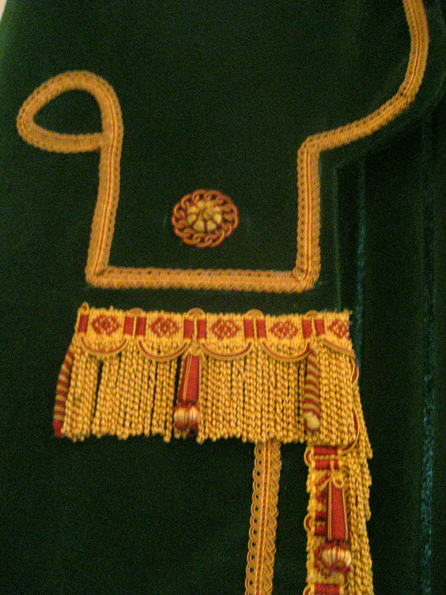fringe (trim) on:
[Wikipedia]
[Google]
[Amazon]

 A Fringe is an ornamental textile trim applied to an edge of a
A Fringe is an ornamental textile trim applied to an edge of a
 A Fringe is an ornamental textile trim applied to an edge of a
A Fringe is an ornamental textile trim applied to an edge of a textile
Textile is an Hyponymy and hypernymy, umbrella term that includes various Fiber, fiber-based materials, including fibers, yarns, Staple (textiles)#Filament fiber, filaments, Thread (yarn), threads, and different types of #Fabric, fabric. ...
item, such as drapery, a flag
A flag is a piece of textile, fabric (most often rectangular) with distinctive colours and design. It is used as a symbol, a signalling device, or for decoration. The term ''flag'' is also used to refer to the graphic design employed, and fla ...
, or epaulettes.
Fringe originated as a way of preventing a cut piece of fabric from unraveling when a hemming was not used. Several strands of weft threads would be removed, and the remaining warp threads would be twisted or braided together to prevent unraveling. In modern fabrics, fringe is more commonly made separately and sewn on. Modern "add-on" fringe may consist of wool
Wool is the textile fiber obtained from sheep and other mammals, especially goats, rabbits, and camelids. The term may also refer to inorganic materials, such as mineral wool and glass wool, that have some properties similar to animal w ...
, silk
Silk is a natural fiber, natural protein fiber, some forms of which can be weaving, woven into textiles. The protein fiber of silk is composed mainly of fibroin and is most commonly produced by certain insect larvae to form cocoon (silk), c ...
, linen
Linen () is a textile made from the fibers of the flax plant.
Linen is very strong and absorbent, and it dries faster than cotton. Because of these properties, linen is comfortable to wear in hot weather and is valued for use in garments. Lin ...
, or narrow strips of leather
Leather is a strong, flexible and durable material obtained from the tanning (leather), tanning, or chemical treatment, of animal skins and hides to prevent decay. The most common leathers come from cattle, sheep, goats, equine animals, buffal ...
. The use of fringe is ancient, and early fringes were generally made of unspun wool (rather than spun or twisted threads).
There are many types of fringe. Particularly in Western Europe, as wealth and luxury items proliferated during the Renaissance, types of fringe began to assume commonly accepted names. Styles of fringes were clearly defined in England
England is a Countries of the United Kingdom, country that is part of the United Kingdom. It is located on the island of Great Britain, of which it covers about 62%, and List of islands of England, more than 100 smaller adjacent islands. It ...
by at least 1688.
Types of fringe include:
*Bullion fringe, is a twisted yarn which generally contains threads of silver
Silver is a chemical element; it has Symbol (chemistry), symbol Ag () and atomic number 47. A soft, whitish-gray, lustrous transition metal, it exhibits the highest electrical conductivity, thermal conductivity, and reflectivity of any metal. ...
or gold
Gold is a chemical element; it has chemical symbol Au (from Latin ) and atomic number 79. In its pure form, it is a brightness, bright, slightly orange-yellow, dense, soft, malleable, and ductile metal. Chemically, gold is a transition metal ...
. The name derives from bullion hose, which had a twisted element at the top that resembled this type of fringe. Modern bullion fringe varies widely in texture and width, but generally is only in length.
*Campaign fringe, from the French word ''campane'' (meaning "bell"), consists of small, bell-like tassels on the end.
*Thread fringe, untwisted and unbraided loose warp threads.
References
Further reading
* Pegler, Martin M. ''The Dictionary of Interior Design''. Fairchild Publications: 1983. Decorative ropework Notions (sewing) Parts of clothing Western wear {{textile-arts-stub